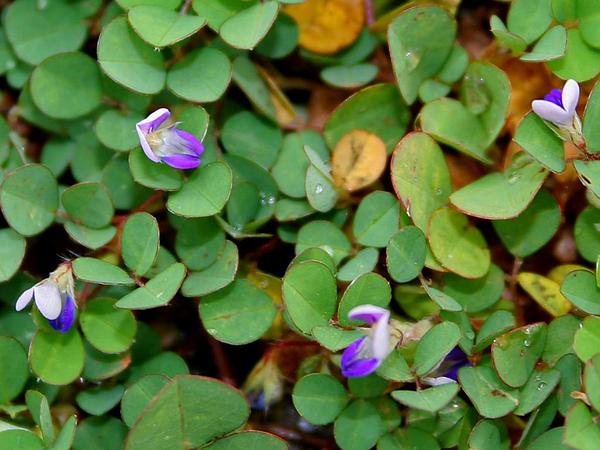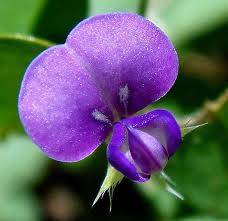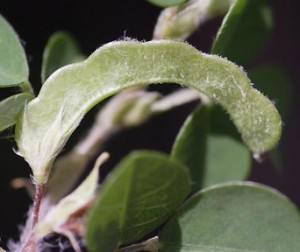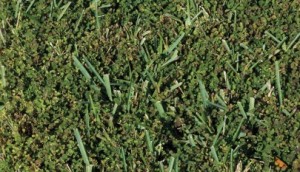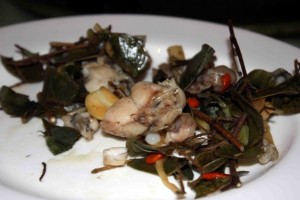Tick Clover barely makes it into our foraging realm.
I have found only one reference to its edibility. In the 47th volume of the Journal of Economic Botany (1993) there is an article called “Ethnobiological Notes On The Khasi And Garo Tribes of Meghalaya, Northeast India.” The 16th entry on page 349 says of Desmodium triflorum* “Cooked preferably mixed with dry fish.” That should give you an idea regarding its flavor. Also called Three Flower Beggarweed, Creeping Tickfoil, Sagotia Beggarweed, and Threeflower, it’s a common weed locally found matting in lawns and parks. Tick Clover blooms in the warmer months and has blue or purplish-pink flowers. You usually find its seeds on your socks or pant legs. More on that in a moment. Some of the members of this genus have edible seeds. I don’t know if this one has edible seeds or not. When I get better health insurance I’ll find out.
Available most of the year and drought resistant Tick Clover is found in Florida, Louisiana, Hawaii, the West Indies, Mexico, Central America, South America, Asia, Sri Lanka, Myanmar (Burma) Thailand, Malaysia, Indo-China, Pacific Islands, Africa and Australia. It’s essentially pantropical. According to the above article in India harvested in March and April.
Desmodium (dez-MOH-dee-um) comes from the Greek word desmos which means a bond or chain, a reference to its jointed fruit, that sticky green loment to the above right. Triflorum(TRY-flor-um) refers to its blossom with three petals, some say refers to three blossoms per stem.
It has at least five other botanical names. Botany is not a settled science. It’s called Tick Clover not because of an insect but because it forms a thick mat and looks like clover. A similar thick cloth is called ticking. That “tick” can be traced to tikke in Middle English, tijk in Dutch, theca in Latin to the original Greek theke meaning a case. In modern Greek it is said Θήκη (THEE-kee) a box, case or receptacle. And for edification the insect called a tick gets its name from a different Greek word. It goes from tick to Middle English “teke” to low German “teke” to the Greek word “Zeche.”
The pea family is an interesting one with edible species and toxic species and not much rhyme or reason to that. Edible leaves in the family are usually high in protein — this one is 18%, according to Bermudez et al. 1968 — but low in taste, more a famine food than table fare. This is also why they are usually cooked and mixed with something else. Every morsel helps to fill an empty tummy. Incidentally, poultry really like Tick Clover, particularly baby chicks.
This brings me to the nice Greek word zoochorous, which should be said zoe-oh-CHOR-us, which is having the spores or seeds dispersed by animals. Life and animals et cetera in Greek are zoe-OH, which got mangled through Latin into the English word zoo. When seeds like the Tick Clover are carried on the fur it is called epizoochory. When carried inside for later deployment it is endozoochory. Now you know.
*They misspelled the Latin name of the plant in the article using an extra “i” writing it triflorium rather than triflorum.
Green Deane’s “Itemized” Plant Profile: Tick Clover
IDENTIFICATION: Desmodium triflorum: A small prostrate legume with a woody taproot. Strongly branched stems covered with yellow-brown hairs. The plant can form roots at the nodes of the stem. Trifoliate leaves with heart-shaped leaflets to a 3/8 of an inch long (10-12 mm.) Pink to purple flowers. Pods flat, two to four rounded segments which are straight across the back when hooked together. They break easily and cling to clothes. It’s also much smaller than a common relative Creeping Beggarweed, Desmodium incanum, which also grows locally. D. incanum has much larger leaves, two inches long or more.
TIME OF YEAR: Available most of the year.
ENVIRONMENT: Pastures, truck farms, roadsides, lawns, open pinewoods. Very shade tolerant, frost intolerant. Found on a wide variety of soils.
METHOD OF PREPARATION: Leaves boiled. This a plant that has many medicinal applications as well.
HERB BLURB
This study evaluated the antioxidant and antiproliferative activities of the crude extract and fractions of Desmodium triflorum (L.) DC. The total phenolic content, 1,1-diphenyl-2- picrylhydrazyl hydrate (DPPH) free radical scavenging activity, trolox equivalent antioxidant capacity (TEAC), reducing power, total flavonoid content of D. triflorum were evaluated for the exploration of its antioxidant activities. Furthermore, its antiproliferative activities were investigated through the MTT method. It was compared with the antioxidant capacities of known antioxidants, including catechin, α-tocopherol, trolox and ascorbic acid. Among all fractions, ethyl acetate fraction was the most active in scavenging DPPH and TEAC radicals, of which 0.4 mg was equivalent to 186.6 ± 2.5 μg and 82.5 ± 2.1 μg of α-tocopherol and trolox respectively. The total phenolic and flavonoid contents of the crude extract were equivalent to 36.60 ± 0.1 mg catechin and 45.6 ± 0.6 mg rutin per gram respectively. In the reducing power assay, 1.25 mg of crude extract was similar to 61.2 ± 0.3 μg of ascorbic acid. For the assessment of the safety and toxicity of D. triflorum, LD50 of the crude extract was greater than 10 g/kg when administered to mice through gastric intubation. The above experimental data indicated that D. triflorum was a potent antioxidant medicinal plant, and such efficacy may be mainly attributed to its polyphenolic compounds.

